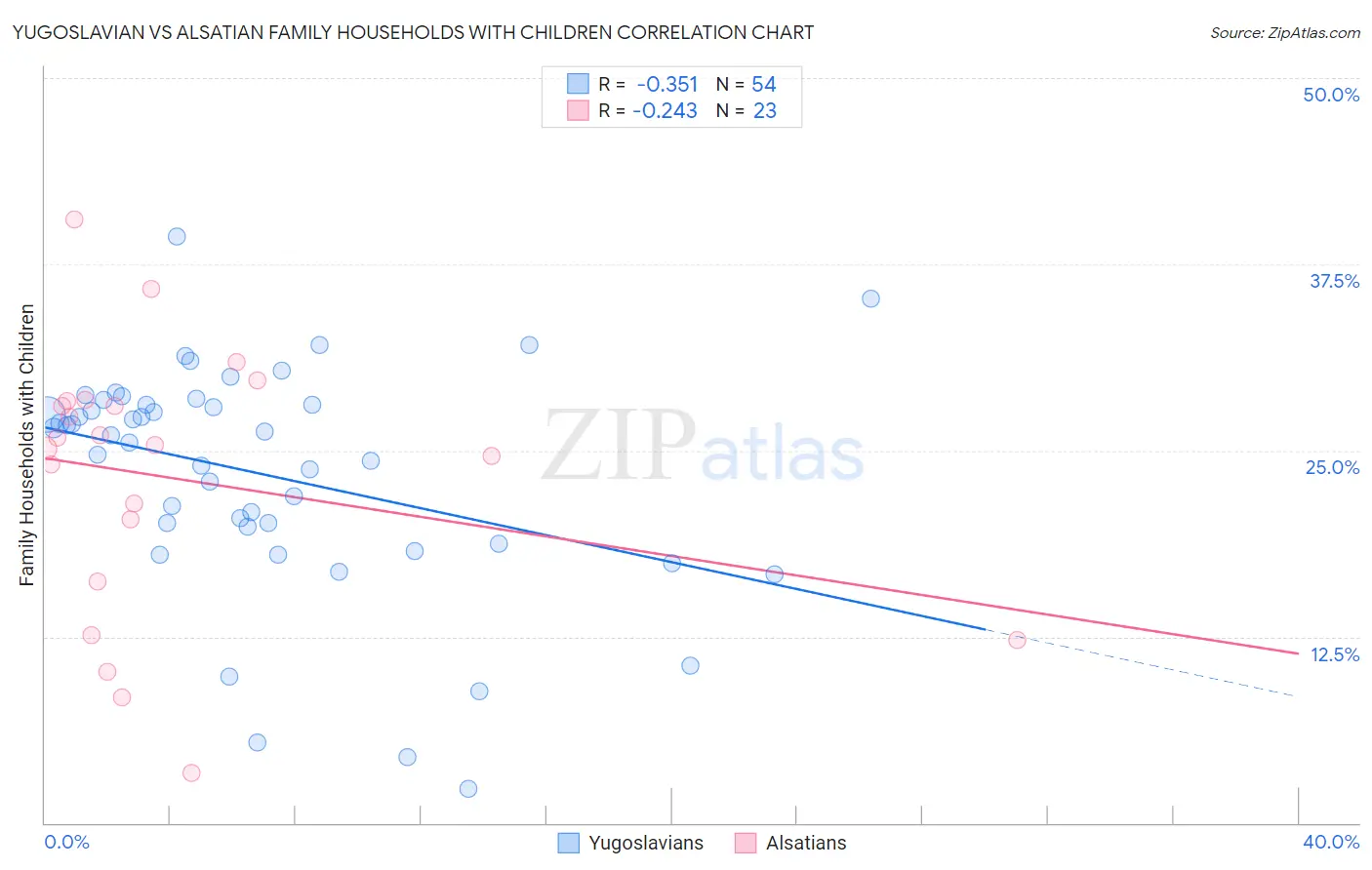Yugoslavian vs Alsatian Family Households with Children
COMPARE
Yugoslavian
Alsatian
Family Households with Children
Family Households with Children Comparison
Yugoslavians
Alsatians
27.0%
FAMILY HOUSEHOLDS WITH CHILDREN
5.1/ 100
METRIC RATING
232nd/ 347
METRIC RANK
25.3%
FAMILY HOUSEHOLDS WITH CHILDREN
0.0/ 100
METRIC RATING
342nd/ 347
METRIC RANK
Yugoslavian vs Alsatian Family Households with Children Correlation Chart
The statistical analysis conducted on geographies consisting of 285,532,788 people shows a mild negative correlation between the proportion of Yugoslavians and percentage of family households with children in the United States with a correlation coefficient (R) of -0.351 and weighted average of 27.0%. Similarly, the statistical analysis conducted on geographies consisting of 82,641,288 people shows a weak negative correlation between the proportion of Alsatians and percentage of family households with children in the United States with a correlation coefficient (R) of -0.243 and weighted average of 25.3%, a difference of 6.8%.

Family Households with Children Correlation Summary
| Measurement | Yugoslavian | Alsatian |
| Minimum | 2.3% | 3.4% |
| Maximum | 39.4% | 40.5% |
| Range | 37.1% | 37.1% |
| Mean | 23.5% | 23.2% |
| Median | 26.1% | 25.4% |
| Interquartile 25% (IQ1) | 19.9% | 16.2% |
| Interquartile 75% (IQ3) | 28.1% | 28.3% |
| Interquartile Range (IQR) | 8.2% | 12.1% |
| Standard Deviation (Sample) | 7.6% | 9.0% |
| Standard Deviation (Population) | 7.6% | 8.8% |
Similar Demographics by Family Households with Children
Demographics Similar to Yugoslavians by Family Households with Children
In terms of family households with children, the demographic groups most similar to Yugoslavians are Immigrants from Italy (27.0%, a difference of 0.0%), Luxembourger (27.0%, a difference of 0.050%), Bulgarian (27.0%, a difference of 0.070%), Immigrants from Germany (27.0%, a difference of 0.080%), and Immigrants from Morocco (27.0%, a difference of 0.12%).
| Demographics | Rating | Rank | Family Households with Children |
| Canadians | 7.5 /100 | #225 | Tragic 27.1% |
| Czechoslovakians | 6.6 /100 | #226 | Tragic 27.0% |
| Tsimshian | 6.6 /100 | #227 | Tragic 27.0% |
| Scottish | 6.5 /100 | #228 | Tragic 27.0% |
| Immigrants | Caribbean | 6.3 /100 | #229 | Tragic 27.0% |
| Bulgarians | 5.8 /100 | #230 | Tragic 27.0% |
| Luxembourgers | 5.5 /100 | #231 | Tragic 27.0% |
| Yugoslavians | 5.1 /100 | #232 | Tragic 27.0% |
| Immigrants | Italy | 5.0 /100 | #233 | Tragic 27.0% |
| Immigrants | Germany | 4.4 /100 | #234 | Tragic 27.0% |
| Immigrants | Morocco | 4.2 /100 | #235 | Tragic 27.0% |
| Cape Verdeans | 3.6 /100 | #236 | Tragic 26.9% |
| Immigrants | Netherlands | 3.5 /100 | #237 | Tragic 26.9% |
| Moroccans | 3.4 /100 | #238 | Tragic 26.9% |
| Immigrants | Southern Europe | 3.4 /100 | #239 | Tragic 26.9% |
Demographics Similar to Alsatians by Family Households with Children
In terms of family households with children, the demographic groups most similar to Alsatians are Hopi (25.2%, a difference of 0.16%), Pueblo (25.2%, a difference of 0.26%), Immigrants from Grenada (25.2%, a difference of 0.44%), Carpatho Rusyn (25.2%, a difference of 0.44%), and Immigrants from Serbia (25.5%, a difference of 0.68%).
| Demographics | Rating | Rank | Family Households with Children |
| Immigrants | Switzerland | 0.0 /100 | #333 | Tragic 25.7% |
| Slovaks | 0.0 /100 | #334 | Tragic 25.7% |
| Immigrants | Croatia | 0.0 /100 | #335 | Tragic 25.7% |
| Immigrants | West Indies | 0.0 /100 | #336 | Tragic 25.7% |
| Puerto Ricans | 0.0 /100 | #337 | Tragic 25.6% |
| Arapaho | 0.0 /100 | #338 | Tragic 25.6% |
| Immigrants | St. Vincent and the Grenadines | 0.0 /100 | #339 | Tragic 25.6% |
| Immigrants | Armenia | 0.0 /100 | #340 | Tragic 25.6% |
| Immigrants | Serbia | 0.0 /100 | #341 | Tragic 25.5% |
| Alsatians | 0.0 /100 | #342 | Tragic 25.3% |
| Hopi | 0.0 /100 | #343 | Tragic 25.2% |
| Pueblo | 0.0 /100 | #344 | Tragic 25.2% |
| Immigrants | Grenada | 0.0 /100 | #345 | Tragic 25.2% |
| Carpatho Rusyns | 0.0 /100 | #346 | Tragic 25.2% |
| Soviet Union | 0.0 /100 | #347 | Tragic 24.8% |